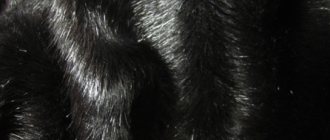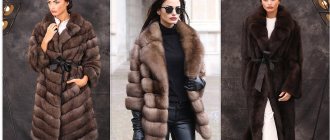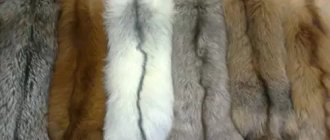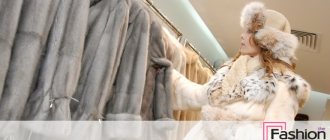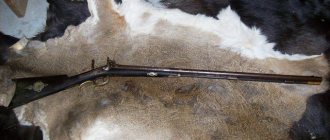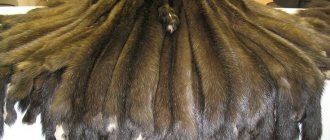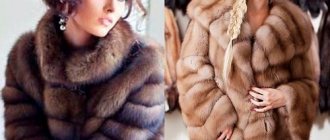You can buy mink skins, fur sets made from mink skins in Moscow at wholesale prices at retail at '.
Mink skins retail and wholesale, fur sets made from mink skins, color GRAPHITE, buy in Moscow, size M00 (68-70cm) - 39,000 rubles. Very dense fur, silky, special dressing and tinting for making fur coats.
Mink skins retail and wholesale, fur sets made from mink skins, Sapphire dyed, buy in Moscow, size M00 (68-70cm) - 3800 rubles. Very dense fur, silky, special dressing and tinting for making fur coats.
Mink skins retail and wholesale, fur sets made from Scan Black mink skins, buy in Moscow, size M1 (60-63cm) - 2600 rubles. Very dense fur, silky, special dressing and tinting for making fur coats.
Mink skins at retail, fur sets made from mink skins, color RED, size M00 (68-70 cm) - 3800 rubles. Very dense fur, silky, special dressing and tinting for making fur coats.
Fur sets made of mink skins, color WINE, size M0 (65-68cm) - 3600 rubles. Very dense fur, silky, special dressing and tinting for fur coats.
Fur sets made of mink skins Sapphire, size M0 (65-68cm) - 3000 rubles, M00 (67-70cm) - 3200 rubles. Very dense fur, silky, special dressing and tinting for fur coats.
Fur sets made of Pink Crystal mink skins, size M1 (60-62cm) -3200 rubles, M0 (65-68cm) -3500 rubles, M00 (67-70cm) -3700 rubles. Very dense fur, silky, special dressing and tinting for sewing fur coats.
Fur sets made of mink skins Terracotta Rose, size M1 (60-62cm)-3200 rubles, M0 (65-68cm)-3500 rubles, M00 (67-70cm)-3700 rubles. Very dense fur, silky, special dressing and tinting for sewing fur coats.
Fur sets made from mink skins Scan Black Velvet, size M00 (67-72cm) - 4000 rubles, M000 (71-75cm) - 42000 rubles. Very dense fur, silky, special dressing and tinting for sewing fur coats.
Fur sets made from Scan Black mink skins, size M0 (65-68cm) - 3200 rubles, M00 (67-70cm) - 3500 rubles, M000 (71-75cm) - 3700 rubles. Very dense fur, silky, special dressing and tinting for sewing fur coats.
Fur sets made of mink skins Gradation, size M0 (65-68cm)-3800/4000 rubles, M00 (67-70cm)-4000/4200 rubles, M000 (69-73cm)-4200/4400 rubles. Very dense fur, silky, special dressing and tinting for sewing fur coats.
Fur sets made of mink skins Gradation, size M0 (65-68cm)-3800/4000 rubles, M00 (67-70cm)-4000/4200 rubles, M000 (69-73cm)-4200/4400 rubles. Very dense fur, silky, special dressing and tinting for sewing fur coats.
Mink skins Gradation Graphite, size M0 (65-68cm)-3800/4000 rubles, M00 (67-70cm)-4000/4200 rubles, M000 (69-73cm)-4200/4400 rubles. Very dense fur, silky, special dressing and tinting for sewing fur coats.
Mink skins Gradation Cappuccino, size M0 (65-68cm)-3800/4000 rubles, M00 (67-70cm)-4000/4200 rubles, M000 (69-73cm)-4200/4400 rubles. Very dense fur, silky, special dressing and tinting for sewing fur coats.
Mink skins Gradation Eggplant, size M0 (65-68cm)-3800/4000 rubles, M00 (67-70cm)-4000/4200 rubles, M000 (69-73cm)-4200/4400 rubles. Very dense fur, silky, special dressing and tinting for sewing fur coats.
Untreated mink skins
Quality of free mink skins (untreated)
Based on the quality of fur and habitat, the skins are divided into ridges:
From north to south, the size of the free mink increases, the color becomes lighter, the fur is coarser, shorter and thinner.
In the spring, molting begins with thinning of the fur on the sides and on the neck, its redness, and the change of hair occurs slowly. Even in June, there are specimens that have not begun to noticeably shed, but have only become reddish. The spring shedding imperceptibly transitions into the autumn - in summer there is fur with sparse dry hair, and there is practically no fluff. Autumn molting involves the change of summer fur to winter fur in the direction from the tail to the head.
Based on the quality of fur and leather fabric, skins are divided into varieties:
Defects of free mink skin
Quality control
Assessment of the quality of untreated free-range mink skins (%)
Quality of caged mink skins (untreated)
Caged mink skins are divided by gender - male and female skins. Males are approximately one third larger than females.
Based on the quality of fur and flesh, the skins are divided into varieties:
Colors (fur color) of mink skins
STCH (standard dark black) Scanblack STK (standard dark brown) Mahogany SK (standard) Brown Krestovka black Krestovka sapphire Krestovka palomino Krestovka pearl Black crystal Silver-blue Sapphire Pastel Palomino Pearl Glow White
Skin sizes
Defects in caged mink skins
Definition of vices
Quality control
Quality assessment of untreated caged mink skins (%)
Features of shooting and processing mink skins
Wild and caged mink skins differ significantly in hair color. There are two types of wild mink: European and American. The European mink lives in the European part of the country. American mink is most often bred in cage conditions. Free minks are brown or light brown in color. Cellular - can have a variety of shades from light black to dark brown.
They come in gray, gray-blue, beige, black with black spots, etc. The skins have lush hair on the rump and ridge; the hair here has a noticeable shiny spine. On the scalp and head the hair is lower and sparse. Mink skins also vary significantly in size. There are: small skins (3-4.5 sq. dm), medium (4.5-6 sq. dm), large (6-8 sq. dm), extra large (8-9.5 sq. dm) and especially large (over 9.5 sq. dm). Skinning Mink skins are removed with a tube, preserving the fur, from the head, paws and tail. On the rump, the skin incision runs along the line of the oncoming flow of hair from the rump and the caul. The skin on the wrists and toes is not cut, which makes it possible to remove the skin from these parts with a bag of claws. The phalanges of the fingers are removed with nippers or scissors, leaving only the claws on the skin. The fingertips are cut off along with the phalanges.
The “twig” of the tail is removed with pliers. The ear cartilages are cut at the level of the skull bone and removed with wire cutters or pliers. The skin is removed from the head using a sharp knife. The skin from the nose, lips and around the eyes is completely removed so that the whiskers (vibrissae) and eyelashes are preserved. The skin is removed from the body in a horizontal or vertical position, securing the carcass in the head area with a hook, loop or clamp.
Degreasing There is usually a lot of subcutaneous fat left on mink skins. Fat is removed, as it prevents the skins from drying and, when oxidized, destroys their leather tissue. Fat is scraped off from the flesh with various instruments. If the hunter does not have sufficient experience in degreasing skins, it is advisable to use a metal spoon with slightly sharpened edges as a tool. Experienced hunters remove fat “by cutting”, using a sharpened clip, scythe, etc. To degrease, the mink skin is placed on a round blank with the inside out. If the skin is obtained during a period when hair growth has not yet finished, then such skins are kept for a short time in a warm place so that the fat melts, and they are squeezed out repeatedly from under the film of subcutaneous tissue using a dry rag and sawdust.
Rice. 1. Blanks for degreasing mink skins and degreasing the skins on a bracket
Editing The fat-free skin is straightened with the inside out (Fig. 2). Editing the skins should be symmetrical. The tail is well spread in width, making it shorter, and with some landing it is fixed on the rule. When the tail is fixed without being seated and spread out wide, after drying it appears that it is sewn or glued to the skin, which deteriorates the presentation of the fur.
Rice. 2. Rules for mink skins
Table. Rule sizes for mink skins
| Rule number | Dimensions, mm | |||||||||
| A | B | IN | G | D | E | AND | 3 | AND | TO | |
| 1 | 250 | 28 | 30 | 40 | 51 | 58 | 55 | 78 | 1200 | 15 |
| 2 | 300 | 25 | 28 | 37 | 48 | 58 | 63 | 74 | 1100 | 15 |
| 3 | 250 | 24 | 26 | 34 | 44 | 54 | 58 | 68 | 1000 | 14 |
| 4 | 210 | 23 | 25 | 32 | — 42 | 45 | 45 | 58 | 900 | 14 |
The head part of the skin is secured to the straightener with small nails. One nail is driven into the nose of the skin and two into the lower lip. The shape given to the head of the skin can be preserved on a straightener by wrapping its core with a strip of clean, wet paper. The rump of the skin is straightened into a straight line and reinforced with two nails at the base of the tail, and two on the sides. Strips of wet paper are also placed on the bottom of the casing and on the rump.
The hind legs are adjusted in different ways: they are made either wide and short and dried on strips of paper, or wide and semi-long and, straightened along the tail, strengthened with nails or a small wooden plank, which is placed on both legs and nailed with one nail. With this editing, the paws fit tightly to the tail, and this improves the appearance of the natural skin.
The front paws are trimmed and dried in the same way as the hind paws. Lumps of paper or bundles of tow, or special sticks are inserted inside the “tubes” of the front paws so that when turning them inside, you can stick the paws inside the skin. Some hunters secure the hind legs to the guide with narrow rubber rings, which are cut from old bicycle inner tubes. Mink skins are sorted by size into 3 groups: large with an area of over 700 cm2, medium - from 600 to 700 cm2 and small - less than 600 cm2. But it is not recommended to stretch the skin on the rule. It should be taken into account that stretching the skins widthwise gives a greater increase in area than tightening them lengthwise.
But, as practice has shown, stretching the skins more than 8 cm in width is advisable only for especially thick-haired and large skins. Therefore, for convenience in work, it is advisable to make a mark on each rule that allows you to quickly determine the minimum length that medium and large-sized sandpaper should have, taking into account the possibility of shrinkage of the skin after removing it from the rule. Preservation and storage When preserving and storing skins at a temperature of 20-25 ° C and a relative humidity of 50-65%, shrinkage of the leather tissue does not occur. The dried skin is removed from the straightener and left for some time so that it “comes off”, that is, it loses its fragility and brittleness. After this, the skin is slightly crushed and carefully turned outward with the hair out (Fig. 3). Sorting Mink skins are sorted by size (which ranges from 40 to 75 cm), age, time of slaughter and gender. The skins of females must be processed separately from the skins of males, as they have a thinner and more elastic inner skin. To tan female skins, smaller doses of chemicals and shorter tanning times are required. 1. Soaking. First method In warm water (26°C) dilute 45 g/l table salt, 2 g/l washing powder (or 3 g/l laundry soap) and 1 g/l soda ash. The duration of the bath is 4-8 hours (with 2-3 stirrings). Second method In warm water (36°C) dilute 30 g/l table salt, 2 g/l laundry soap, 1 g/l soda ash and 1 g/l OP-10 wetting agent. The duration of the bath is 4-8 hours (with 2-3 stirrings). The skins are given 1-2 hours to swell, after which they are rinsed in clean water at a temperature of 32°C.
Rice. 3. Mink skins:
A - on a straightener with the flesh facing out with strips of paper on the head, paws and rump;
B - dried with fur out
Third method In warm water (36°C) dilute 45 g/l of table salt and 1 g/l of 25% ammonia, which softens the water. The duration of the bath is 6-8 hours (with 2-3 stirrings). Fourth method (for summer slaughtered skins) 45 g/l of table salt and 1 ml/l of acetic acid (or 0.3 ml/l of sulfuric acid) are diluted in warm water (36°C). The duration of the bath is 6-10 hours (with 2-3 stirrings). The first soaking is followed by swelling of the skins, breaking and a second soaking in the spent solution (another 2-3 hours). If hair loss is observed during soaking, the skins must be salted immediately after swelling, bypassing the degreasing process. Method (for skins that have not undergone degreasing before canning). In warm water (36°C) dilute 45 g/l table salt, 2 g/l washing powder, 3 g/l technical borax (or 2 g/l trisodium phosphate). The duration of the bath is A-6 hours. After the first soaking, swelling, breakdown, a second soaking in the used solution (2-3 hours) and a third soaking in a new solution containing 30 g/l of table salt (temperature - 32°C, duration - 3-4 hours) follow. After any method of soaking, the skins are allowed to swell for 1-2 hours. 2. Fleshment. 3. Degreasing The first method (for skins degreased with gasoline or turpentine before canning). 3 g/l of washing powder for wool (without bioadditives and bleaching agents) and 1 g/l of calcined salt are diluted in water at a temperature of 36°C. The duration of the bath is 1 hour (3-4 stirrings). This is followed by swelling of the skins and two washes: the first wash is in water (32ºC) with the addition of 2-3 ml/l of 25% ammonia, for 30 minutes; after washing, the skins are removed for 20-30 minutes of swelling; the second wash is in clean water at a temperature of 30°C. within 20-30 minutes. The skins are degreased turned inside out (hair side out). After the second washing, the skins are turned inside out and allowed to swell for 1-2 hours. Second way. 2-3 t/l of laundry soap and 2-3 g/l of soda ash are diluted in warm water (36°C). The duration of the bath is 1 hour (with 2-3 stirrings). After the first soaking, the skins are swollen (20-30 minutes) and two washes: the first wash is in water (32°C) with the addition of 0.5 g/l laundry soap and -0.5 g/l soda ash, for 30 min (with constant stirring of the skins); followed by 20-30 minutes of swelling; second rinsing - in clean water at a temperature of 30°C, for 20-30 minutes. Third method: In warm water (36°C) dilute 1 g/l washing powder, 2 g/l OP-10 wetting agent or cheap shampoo, 1 g/l soda ash. The duration of the bath is 1 hour (with 2-3 stirrings). After the first soak, the skins are allowed to swell (30 minutes) and two washes: the first wash is in water (32°C) with the addition of 0.5 g/l of OP-10 wetting agent and 0.5 g/l of washing powder, for 30 minutes ; followed by 30 minutes of swelling; the second rinse - in water at a temperature of 30°C with the addition of 2 ml/l of 25% ammonia, for 20 minutes. Fourth method In warm water (36°C) dilute 3 g/l of washing powder, 3 ml/l of 25% ammonia. The duration of the bath is 1 hour (with 2-3 stirrings). The first soaking is followed by swelling of the skins (20 minutes) and two rinses in clean water at a temperature of 30°C (for 30 minutes). Between washings there is a short swelling. Fifth method: Dilute 3 g/l of washing powder or washing paste in warm water (36°C). The duration of the bath is 40-60 minutes (with 2-3 stirrings). After the first soak, swelling of the skins follows (20 minutes) and two. rinsing in clean water at a temperature of 30°C (for 30 minutes). Between washings there is a short swelling. After any type of degreasing, a final swelling of the skins follows for 1-2 hours. 4. Salting. The skins are turned inside out and immersed in an aqueous solution of table salt (45 g of salt per 1 liter of water at a temperature of 32°C). The duration of the bath is 1 hour (with 2-3 stirrings). As you salt, make sure that no hair comes out. If the hair loss still makes itself felt, then 1 ml/l of acetic acid or 0.3 ml/l of sulfuric acid should be added to the solution. When adding acid, the skins are not removed, but are moved to the side so that the acid does not get on them. After gravy, the skins are salted for another 30-40 minutes. 5. Softening. Softening is carried out on the basis of a spent pickling solution with the addition of acid or bread kvass. Softening with acids. Add 1 ml/l of acetic acid or 0.3 ml/l of sulfuric acid to the brine solution and load the skins for 40-60 minutes (with stirring 2-3 times). Finally, swelling over the solution for 20 minutes. Softening with bread kvass. 100 ml/l of bread kvass is added to the brine solution and the skins are loaded for 1-2 hours. After softening, swelling follows for 30 minutes. 6. Pickling. Method with a one-time addition of acid Pickling is carried out on the basis of a spent softening solution with a residual temperature (about 30°C). 2 g/l of OP-10 wetting agent or cheap shampoo is dissolved in 10 times the amount of hot water (80-90°C) and poured into the softening solution, where fur raw materials are then loaded. The skins are removed before adding acid. 1.5-2 g/l of carbamide (urea) and 2 g/l of laundry soap dissolved in water are added to the solution. Excessive addition of urea and laundry soap leads to greasiness of the leather tissue. The solution is thoroughly mixed and acetic acid is added (14 ml/l for females and 18 ml/l for males). Instead of acetic acid, you can use sulfuric acid (2.4 ml/l for females and 2.7 ml/l for males). The duration of pickling after adding acid is 4-6 hours (with stirring every hour).
Method with repeated addition of acid 1 g/l of urea and acetic acid are added to the softening solution (5 ml/l for females and 7 ml/l for males). Pickling duration is 1.5-2 hours (with two stirrings). After this period, the raw materials are removed, 2 ml/l of acetic acid is added and the skins are kept for another 4 hours (with two stirrings). Before the next addition of acid, the skins are removed for 10-20 minutes, and 1 ml/l of 100% sulfuric acid is introduced into the solution. The duration of pickling after the second gravy is 6-8 hours (with two stirrings). After pickling, the skins are given 20-30 minutes to swell. Method with various acids Add 1 g/l of urea and acetic acid to the softening solution (5 ml/l for females and 7 ml/l for males). Pickling duration is 1.5-2 hours (with two stirrings). After this period, the raw materials are removed, 2 ml/l of acetic acid is added and the skins are kept for another 4 hours (with two stirrings). Before the second addition of acid, the skins are removed for 10-20 minutes, 0.5 ml/l of 100% sulfuric acid and 8 g/l of potassium alum are added to the solution. The duration of pickling after the second gravy is 16-18 hours. Peel-treated skins are left to swell for 20-30 minutes. Method of pickling in bread kvass. Pickling in bread kvass is considered the most effective and requires preliminary salting and softening processes. 30 g/l of table salt is added to fresh bread kvass and skins are loaded into it (at the rate of 3-5 l of kvass per 1 kg of fur raw material). The temperature of kvass is no more than 2°C. The duration of fermentation is 2 days (with stirring every 12 hours). The readiness of the skins is determined by the ease of separation of hair in the groin area. After treating the skins with kvass, they are taken out and left to swell for 1-2 hours, and then placed in piles to rest for 12 hours. If the hair is too easily separated from the leather fabric, then tanning is started without curing. 7. Tanning. Before tanning, the skins are rinsed in clean water at a temperature of 28°C (20-30 minutes) and allowed to swell (30-60 minutes). Vegetable tanning In water at a temperature of 30ºC, 25-30 g/l of table salt, tanning agent extract, or 6-8 g/l of factory-made dry tanning agent are diluted. The duration of the bath is 2-3 days. After tanning, the skins are allowed to swell for 2 hours and stored for 12 hours. Chrome tanning 6-8 t/l of chrome alum, previously dissolved in water, is added to the spent pickle solution at a residual temperature. After the first 6 hours of tanning, the skins are removed and 3 g/l of soda ash is added to the solution. Tanning is continued for another 6 hours, after which the fur raw material is removed again, another 2 g/l of soda ash is added to the tanning solution, after which the skins are loaded for another 8-10 hours (with hourly stirring for the first 4 hours). Mixed tanned Tanning is carried out on the basis of spent pickle solution with a residual temperature. Tanning solution: for 1 liter of pickel - 3 g of chrome alum (dissolved by boiling in 10 times the amount of water) and 2 g of soda ash. The skins are kept in the solution for 3-4 hours, stirring every 30 minutes, after which they are removed and 10 ml/l of tanning extract or 2-3 g/l of factory-made dry tanning agent, previously dissolved in boiling water, are added to the tanning solution. The skins are kept in the solution for another 4 hours. After this period, the raw materials are removed again and 1-2 g/l of hyposulfite are added to the solution. The skins are loaded for 6 hours, after which the skins are removed, 2 g/l of soda ash is added to the solution and tanning is continued for another 4-8 hours (while stirring the raw materials every hour in the first 4 hours). Aluminum-potassium tanning 15-20 g/l of potassium-aluminum alum is added to the spent pickel. The skins are loaded for 4-6 hours, after which they are removed and 3 g/l of soda ash is added to the tanning solution. The skins are placed back into the solution for 20-24 hours (with stirring every 6-8 hours). Tanned skins are left for 1-2 hours for swelling and for 12 hours for curing. 8. Fatliquoring.
9. Drying.
The skins are not dried completely, but only 70-80%. Otherwise, the hair becomes wavy, which makes further processing of the fur difficult.
10. Finishing operations:
a) warm-up with hands, after which the skins are turned with the hair out; b) combing the fur with a metal comb (first against the pile, and then in its direction); c) final drying; d) warm-up with hands, after which the skins are turned inside out; e) kneading with a spatula along and across the ridge; f) drying; g) kneading with a spatula until the skin is completely elastic; h) the skins are turned inside out and combed; i) beating out the skin.
Tanned mink skins
Cured skins are divided into the following groups:
Cured skins are divided into varieties:
Based on color, tanned mink skins are grouped into:
Dimensions
Defects
